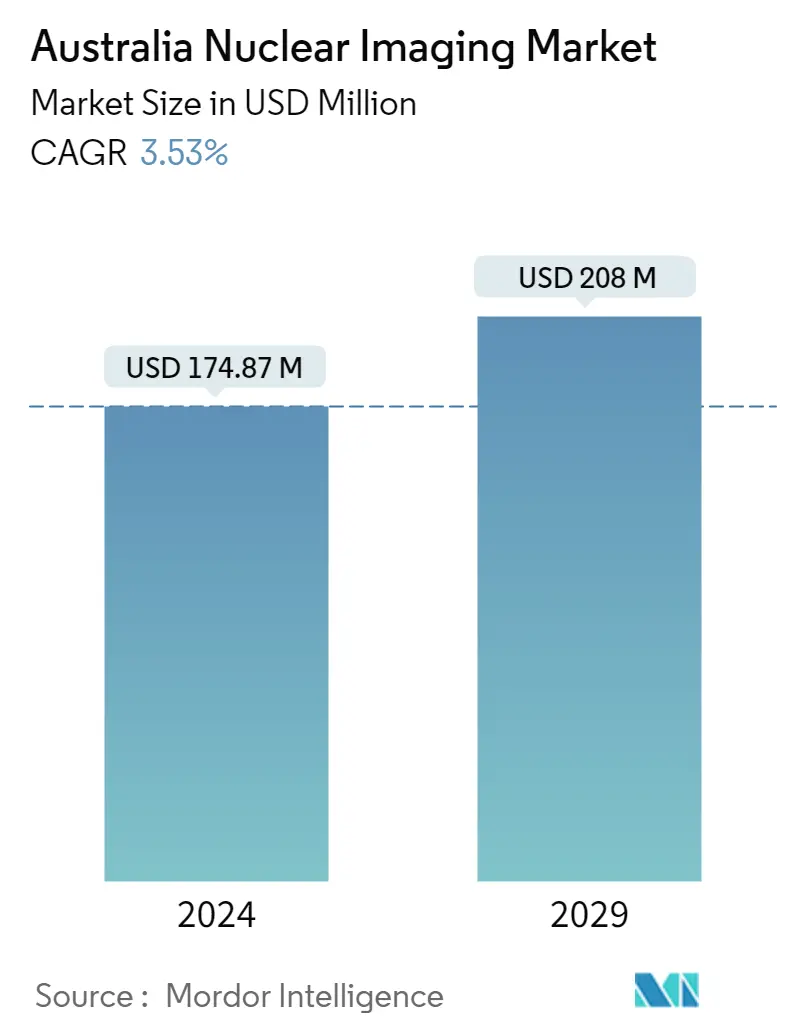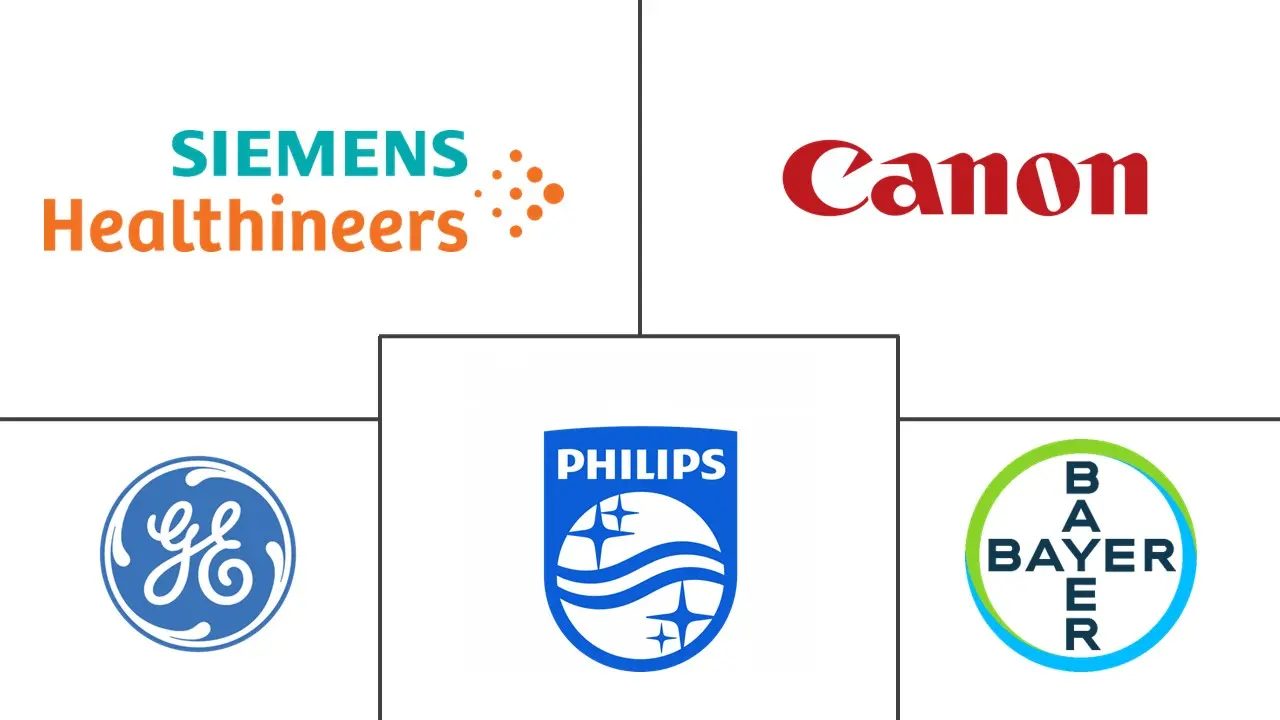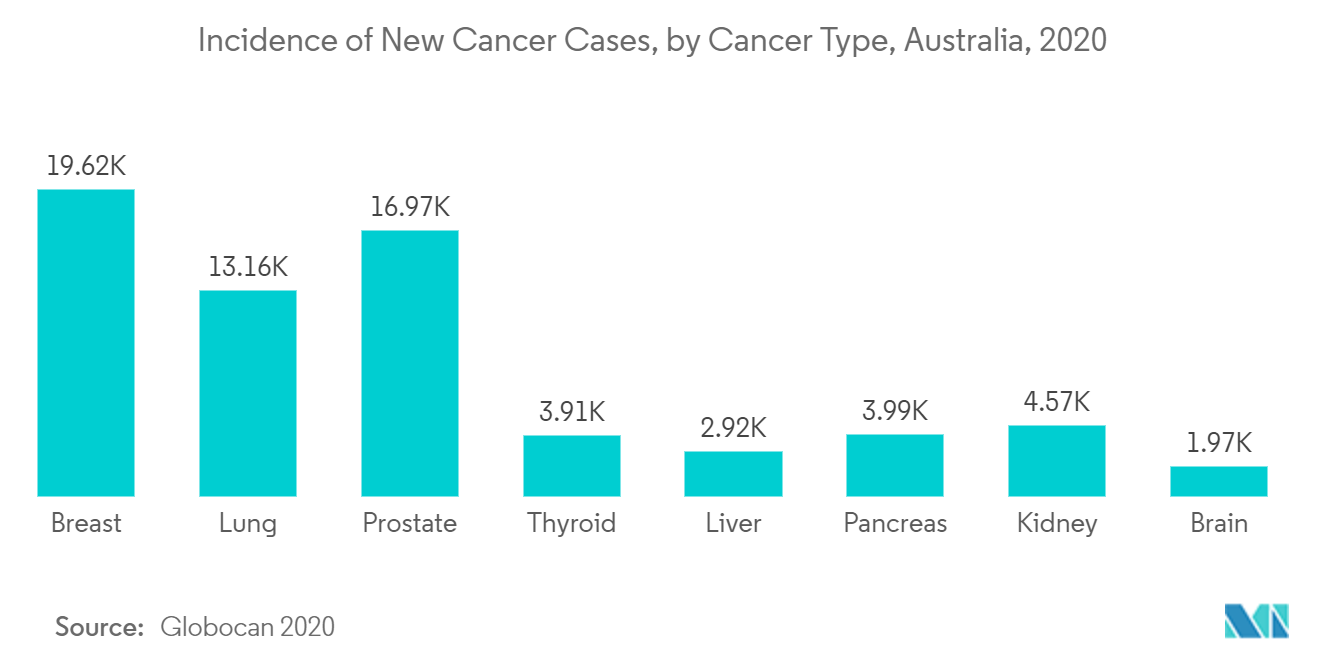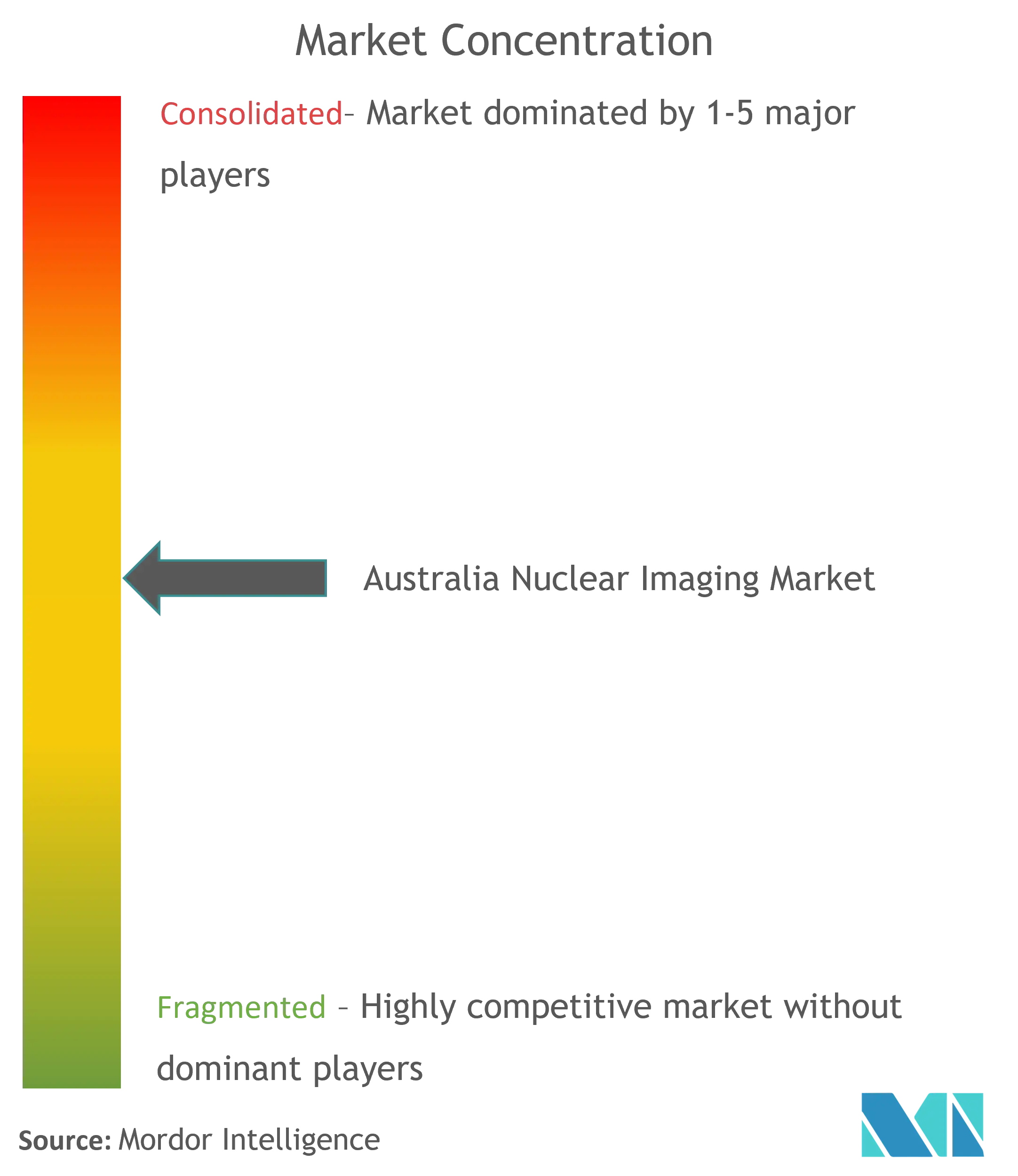Australia Nuclear Imaging Market Size

| Study Period | 2019 - 2029 |
| Base Year For Estimation | 2023 |
| Market Size (2024) | USD 174.87 Million |
| Market Size (2029) | USD 208.00 Million |
| CAGR (2024 - 2029) | 3.53 % |
| Market Concentration | Medium |
Major Players
*Disclaimer: Major Players sorted in no particular order |
Australia Nuclear Imaging Market Analysis
The Australia Nuclear Imaging Market size is estimated at USD 174.87 million in 2024, and is expected to reach USD 208 million by 2029, growing at a CAGR of 3.53% during the forecast period (2024-2029).
The COVID-19 pandemic had a significant impact on the nuclear imaging market in Australia. Various research studies have been published to provide insight into the effects of the pandemic on the studied market. The impact of the COVID-19 pandemic on diagnostic imaging services in Australia, according to research released in July 2020 titled "COVID-19 impact on nuclear medicine: an Australian perspective", showed that nuclear medicine and CT services were relatively less affected than general radiography, ultrasound, and MRI services. Nuclear medicine services were provided less frequently in March 2020 (down 10.1%), April 2020 (down 24.6%), and May 2020 (down 12.3%), with June 2020 (up 11.0%) seeing a notable increase. The country had a severe shortfall in the supply of radiopharmaceuticals during the COVID-19 outbreak, which is anticipated to impede market expansion. A batch of nuclear medicine generators failed the quality check in October 2020, according to an announcement from the Australian Nuclear Science and Technology Organization (ANSTO), which caused a temporary bottleneck in supply. Thus, the market is adversely affected by the pandemic. However, the pending cases are expected to undergo treatment which is expected to increase the market growth in the future.
Technological improvements, expanding diagnostic applications in various diseases such as neurology disorders, government assistance, and the transition from standalone to hybrid modalities are all factors driving the market's growth in Australia. In 2020, Dementia Australia estimates that 459,000 Australians will be affected by dementia. Dementia Australia predicted that by 2058, there will be 1.1 million persons in the world who have dementia. It was the second leading cause of mortality in Australia, the main cause of death for Australian women, and Dementia Australia predicts that it will overtake all other causes of death within the next few years. There is projected to be a significant demand for an accurate diagnosis of the disease given the vast number of people in Germany who live with dementia-related conditions. Since SPECT imaging can be used for the diagnosis of dementia, there is likely to be a demand for this application in the forecast period.
The Appropriate Use Criteria for PSMA PET Imaging were published in September 2021 by the Australia and New Zealand Society of Nuclear Medicine (ANZSNM) and The Society of Nuclear Medicine and Molecular Imaging (SNMMI). These criteria will be a useful resource for doctors as they choose the most appropriate diagnostic strategy for their patients. Such programs and government assistance will expand Australia's nuclear medical market. Additionally, OncoBeta GmbH, a commercial-stage medical device firm focused on cutting-edge epidermal radioisotope therapy, and the Australian Nuclear Science and Technology Organization established manufacturing cooperation in July 2021. (ANSTO). As part of this, ANSTO will create OncoBeta's cutting-edge Rhenium-SCT therapy, which will be made available by the end of 2021 for the treatment of non-melanoma skin cancer. This will provide a brand-new, very effective therapy alternative to relieve the significant medical burden in Australia. Consequently, nuclear imaging is expanding in Australia. Thus, these factors are likely to increase market growth.
However, the lack of proper reimbursement and stringent regulatory approval procedures, and the high cost of equipment, are expected to impede the market growth in Australia.
Australia Nuclear Imaging Market Trends
This section covers the major market trends shaping the Australia Nuclear Imaging Market according to our research experts:
Equipment Segment is Expected to Hold a Significant Market Share Over the Forecast Period
The Australian market for nuclear imaging equipment is growing owing to the rising prevalence of diseases requiring these scans and the growing technological advancements are the key drivers for the market studied. According to the estimates of the Global Cancer Observatory, in 2020, there were an estimated 200,021 new cancer cases diagnosed and 48,236 cancer deaths in Australia. Furthermore, according to World Nuclear Association 2020, Australia performs about 560,000 nuclear medicine operations annually, with an estimated 90% of those procedures being diagnostic in nature. The growing frequency of these treatments raises the need for scanners, fostering the expansion of the equipment segment in the nation. The country's increasing use of PET scanners for illness imaging and diagnostics has boosted the development of the industry under study. According to the Organisation for Economic Co-operation and Development (OECD) figures, Australia did an estimated 3,714,716 clinical PET scans in 2020 as opposed to 3,573,711 scans in 2019. The deployment of AUD 15 million TB-PET scanners in March 2021 is anticipated to revolutionize Australia's biomedical imaging capabilities, enhance patient outcomes, and strengthen research initiatives in the medical and health sciences. Increasing in the product innovation and technological advancement in the country by key market player expected to boost the nuclear imaging market. Moreover, in April 2021, Koninklijke Philips N.V. installed its most advanced digital diagnostic and interventional neurovascular imaging solutions at Westmead Hospital. Thus, the market is expected to increase in the future.

Australia Nuclear Imaging Industry Overview
Australia nuclear imaging market is moderately competitive and consists of several major players. Some of the companies that are currently dominating the market are GE Healthcare, Siemens Healthineers AG, Canon Inc. (Canon Medical Systems Corporation), Bayer AG, and Koninklijke Philips NV among others.
Australia Nuclear Imaging Market Leaders
-
GE Healthcare
-
Siemens Healthineers AG
-
Koninklijke Philips N.V.
-
Canon Inc. (Canon Medical Systems Corporation)
-
Bayer AG
*Disclaimer: Major Players sorted in no particular order

Australia Nuclear Imaging Market News
- In May 2021, Mediso's reference laboratory at ANSTO, Australia's Nuclear Science and Technology Organization installed the newly acquired nanoScan PET/CT and SPECT/CT preclinical molecular imaging systems.
- In April 2021, Telix Pharmaceuticals Limited, with its headquarters in Melbourne, Australia, partnered with the Oncidium Foundation. As part of the agreement, the NOBLE (Nobody Left Behind) Registry was established. This global registry supports the use of SPECT imaging for men with prostate cancer.
Australia Nuclear Imaging Market Report - Table of Contents
1. INTRODUCTION
- 1.1 Study Assumptions and Market Definition
- 1.2 Scope of the Study
2. RESEARCH METHODOLOGY
3. EXECUTIVE SUMMARY
4. MARKET DYNAMICS
- 4.1 Market Overview
-
4.2 Market Drivers
- 4.2.1 Increasing Prevalence of Chronic Diseases
- 4.2.2 Rising Geriatric Population
- 4.2.3 Increasing Technological Advancements
-
4.3 Market Restraints
- 4.3.1 Lack Of Proper Reimbursement And Stringent Regulatory Approval Procedures
- 4.3.2 High Cost of Equipment
-
4.4 Porter's Five Force Analysis
- 4.4.1 Threat of New Entrants
- 4.4.2 Bargaining Power of Buyers/Consumers
- 4.4.3 Bargaining Power of Suppliers
- 4.4.4 Threat of Substitute Products
- 4.4.5 Intensity of Competitive Rivalry
5. MARKET SEGMENTATION (Market Size by Value - USD million)
-
5.1 By Product
- 5.1.1 Equipment
- 5.1.2 Diagnostic Radioisotope
- 5.1.2.1 SPECT Radioisotopes
- 5.1.2.2 PET Radioisotopes
-
5.2 By Application
- 5.2.1 SPECT Application
- 5.2.1.1 Cardiology
- 5.2.1.2 Neurology
- 5.2.1.3 Thyroid
- 5.2.1.4 Other SPECT Applications
- 5.2.2 PET Application
- 5.2.2.1 Oncology
- 5.2.2.2 Cardiology
- 5.2.2.3 Neurology
- 5.2.2.4 Other PET Applications
6. COMPETITIVE LANDSCAPE
-
6.1 Company Profiles
- 6.1.1 GE Healthcare
- 6.1.2 Bayer AG
- 6.1.3 Fujifilm Holdings Corporation
- 6.1.4 Bracco Group
- 6.1.5 Novartis AG (Advanced Accelerator Applications)
- 6.1.6 Canon Inc. (Canon Medical Systems Corporation)
- 6.1.7 Mediso Ltd.
- 6.1.8 Koninklijke Philips N.V.
- 6.1.9 Siemens Healthineers AG
- *List Not Exhaustive
7. MARKET OPPORTUNITIES AND FUTURE TRENDS
** Subject To AvailablityAustralia Nuclear Imaging Industry Segmentation
As per the scope of the report, nuclear medicine imaging procedures are non-invasive, with the exception of intravenous injections, and are usually painless medical tests that help physicians diagnose and evaluate medical conditions. These imaging scans use radioactive materials called radiopharmaceuticals or radiotracers. These radiopharmaceuticals are used in diagnosis and therapeutics. They are small substances that contain a radioactive substance that is used in the treatment of cancer, cardiac and neurological disorders. Australia Nuclear Imaging Market is segmented by Product (Equipment, and Diagnostic Radioisotope (SPECT Radioisotopes, and PET Radioisotopes), Application (SPECT Application (Cardiology, Neurology, Thyroid, and Other SPECT Applications), and PET Application (Oncology, Cardiology, Neurology, and Other PET Applications). The report offers the value (in USD million) for the above segments.
| By Product | Equipment | |
| Diagnostic Radioisotope | SPECT Radioisotopes | |
| PET Radioisotopes | ||
| By Application | SPECT Application | Cardiology |
| Neurology | ||
| Thyroid | ||
| Other SPECT Applications | ||
| By Application | PET Application | Oncology |
| Cardiology | ||
| Neurology | ||
| Other PET Applications |
Australia Nuclear Imaging Market Research FAQs
How big is the Australia Nuclear Imaging Market?
The Australia Nuclear Imaging Market size is expected to reach USD 174.87 million in 2024 and grow at a CAGR of 3.53% to reach USD 208.00 million by 2029.
What is the current Australia Nuclear Imaging Market size?
In 2024, the Australia Nuclear Imaging Market size is expected to reach USD 174.87 million.
Who are the key players in Australia Nuclear Imaging Market?
GE Healthcare, Siemens Healthineers AG, Koninklijke Philips N.V., Canon Inc. (Canon Medical Systems Corporation) and Bayer AG are the major companies operating in the Australia Nuclear Imaging Market.
What years does this Australia Nuclear Imaging Market cover, and what was the market size in 2023?
In 2023, the Australia Nuclear Imaging Market size was estimated at USD 168.91 million. The report covers the Australia Nuclear Imaging Market historical market size for years: 2019, 2020, 2021, 2022 and 2023. The report also forecasts the Australia Nuclear Imaging Market size for years: 2024, 2025, 2026, 2027, 2028 and 2029.
Australia Nuclear Imaging Industry Report
Statistics for the 2024 Australia Nuclear Imaging market share, size and revenue growth rate, created by Mordor Intelligence™ Industry Reports. Australia Nuclear Imaging analysis includes a market forecast outlook 2029 and historical overview. Get a sample of this industry analysis as a free report PDF download.



